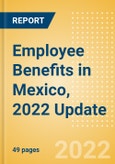Mexico’s social security system was introduced on December 31, 1942, with effect from January 19, 1943, and has since evolved in terms of scope and coverage. The Mexican Social Security Institute (IMSS) and the Institute for Security and Social Services for Government Workers (ISSSTE) are the governing bodies of the social security system. The existing social security system was introduced on July 1, 1997, for voluntary contributions, and on September 1, 1997, for mandatory contributions. The social security system is based on defined contributions instead of the earlier pay-as-you-go system. The system provides coverage for disability, death, and retirement benefits. Individual accounts are created for employees and contributions made by the employee, employer, and the government is credited therein.
The report provides in-depth industry analysis, information, and insights of the employee benefits in Mexico, including an overview of the state and compulsory benefits in Mexico, detailed information about the private benefits in Mexico, insights on various central institutions responsible for the administration of the different branches of social security and the regulatory framework of the employee benefits in Mexico.
This report provides a detailed analysis of employee benefits in Mexico:
The report provides in-depth industry analysis, information, and insights of the employee benefits in Mexico, including an overview of the state and compulsory benefits in Mexico, detailed information about the private benefits in Mexico, insights on various central institutions responsible for the administration of the different branches of social security and the regulatory framework of the employee benefits in Mexico.
Key Highlights
- The ISSSTE, Instituto Mexicanodel Seguro Social (IMSS), and Administradora de Fondos para el Retiro (Afore), are responsible for the functioning of the overall social security system
- A person’s national insurance contribution is determined based on their income
- An insured person who is unemployed or unable to work and whose benefits have been exhausted is entitled to credited contribution
- In Mexico, employers provide voluntary retirement benefits to their employees through voluntary DB, DC, hybrid and mixed pension plans
Scope
This report provides a detailed analysis of employee benefits in Mexico:
- It offers a detailed analysis of the key government-sponsored employee benefits, along with private benefits
- It covers an exhaustive list of employee benefits, including retirement benefits, death in service, long-term disability benefits, medical benefits, workmen's compensation insurance, maternity and paternity benefits, family benefits, unemployment, compensation, leaves and holidays and private benefits
- It highlights the economic and regulatory situations relating to employee benefits in Mexico
Reasons to Buy
- Make strategic decisions using in-depth information related to employee benefits in the country
- Assess employee benefits of the market, including state and compulsory benefits and private benefits
- Gain insights into the key employee benefit schemes offered by private employers in the country
- Gain insights into key organizations governing employee benefits market, and their impact on companies
Table of Contents
1. Executive Summary3. Country Statistics4. Overview of Employee Benefits Mexico5. Regulations
2. Introduction
6. State and Compulsory Benefits
7. Private Benefits
List of Tables
List of Figures








